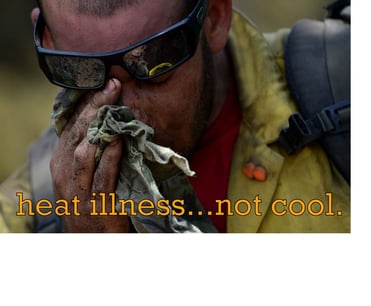KYLE MEINERT
Risk Advisory AT HNI
OSHA has published its main initiatives this year for preventing injuries at the workplace. In this list is a timely topic: heat safety.
According to the CDC around 700 individuals succumb to all that is Mother Nature during these hot  summer months. The common thing in all of these cases? They are 100 percent controllable.
summer months. The common thing in all of these cases? They are 100 percent controllable.
It is our responsibility to educate our workers to make sure that they do not fall into one of these statistics!
What is Heat Illness?
The body normally cools itself by sweating. But during hot weather, especially with high humidity, sweating isn't enough.
Body temperature can rise to dangerous levels if precautions are not taken such as drinking water frequently and resting in the shade or air conditioning. Heat illnesses range from heat rash and heat cramps to heat exhaustion and heat stroke.
Heat stroke requires immediate medical attention and can result in death.
How Heat Illness Can Be Prevented
Employers should be proactive about encouraging workers to “keep it cool” and communicate heat illness prevention practices. This includes:
- providing workers with water, rest and shade
- gradually increasing workloads
- allowing more frequent breaks for new workers or workers who have been away for a week or more to build a tolerance for working in the heat (acclimatization)
- modifying work schedules as necessary
- planning for emergencies and training workers about the symptoms of heat-related illnesses and their prevention
- monitoring workers for signs of illness
Who is at risk for heat safety issues?
Who isn’t affected is an easier question to answer! All workers exposed to hot and humid conditions are at risk, and can benefit from a refresher course on summer heat safety -- especially those doing heavy work tasks or using bulky protective clothing and equipment.
Working in full sunlight can increase heat index values by 15 degrees Fahrenheit. Keep this in mind and plan additional precautions for working in these conditions.
Some workers might be at greater risk than others if they have not built up a tolerance to hot conditions, including new workers, temporary workers, or those returning to work after a week or more off. This also includes everyone during a heat wave.
Industries most affected by heat-related illness are: construction, trade, transportation, utilities, agriculture, building, grounds maintenance, landscaping services, and support activities for oil and gas operations.
Tips to Share with Your Team on Summer Heat Safety: Declare WARS
To prevent heat related illness and fatalities:
- Drink water every 15 minutes, even if you are not thirsty.
- Rest in the shade to cool down.
- Wear a hat and light-colored clothing.
- Learn the signs of heat illness and what to do in an emergency.
- Keep an eye on fellow workers.
- "Easy does it" on your first days of work in the heat. You need to get used to it.
Need a quick way to remind people of the most important elements of heat safety? Just tell them we’re at WARS. No big booms or Private Ryan – just a useful acronym for prevention of heat casualties:
- Water Don’t wait until you’re thirsty to drink!
- Acclimation Let’s not be a heat hero; day one on the job.
- Rest Rest is for the weak? Nope, rest is for the living.
- Shade Work smarter… not hotter.
Stay cool (and safe) out there!
Related Posts:
Changing Employee Behavior Starts By Getting the Incentives Right
Why Strong Employee Onboarding Matters [Onboarding 101: The Series]
5 Best Practices for Onboarding [Onboarding 101: The Series]
.png?width=69&height=53&name=Acrisure%20Logo%20(White%20Horizontal).png)

